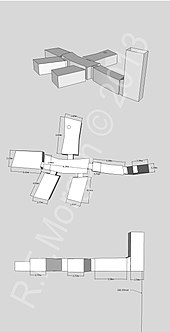KV30
|
KV30 |
|
|---|---|
| place | Valley of the Kings |
| Discovery date | 1817 |
| excavation | Giovanni Battista Belzoni |
| Previous KV29 |
The following KV31 |
The ancient Egyptian tomb KV30 in the Valley of the Kings (Eastern Valley ) was discovered in 1817 by Giovanni Battista Belzoni , who dug for Earl Belmore . The grave is therefore also called "Earl Belmore's Grave". The owner of the grave is unknown.
Research and Publication
After its discovery in 1817, James Burton in 1825 and Victor Loret in 1898 visited the tomb and made illustrations of it. A publication on the work in the grave was not published. The Egyptologist Elizabeth Thomas also examined the grave and described it briefly.
In 2009, a team from the University of Basel's Egyptology Department worked in KV30 as part of the University of Basel Kings' Valley Project . A first photographic documentation of the grave could be created. An evaluation of the finds is planned for the following excavation season. After the work in the grave was finished, it was closed again.
Location and architecture
KV30 is located in the southwest wadi of the Valley of the Kings and is located approx. 40 m north of KV32 . The design of the grave is similar to KV5 , but also to KV12 and KV27 . It has a total length of 42.06 m and consists of a shaft, a corridor that ends in a chamber. Three further side chambers lead off from the corridor. Research showed a good quality of the rock in which it was worked. The rock itself is only roughly worked and the grave has no decorations. However, while working in the grave, James Burton discovered a mark made of red characters that he believed to be stone carving marks. According to the research carried out in 2009, the red ink graffiti is not that of a stonemason.
Finds
Elizabeth Thomas discovered a pottery shard, which was the only documented find of the grave so far. The property can be assigned to the 18th dynasty . It is uncertain whether the sarcophagus (EA 39) donated to the British Museum by Earl Belmore , which also dates to the 18th Dynasty, comes from this tomb or KV31. The excavation team of the Egyptological seminar at the University of Basel, under the direction of Susanne Bickel, found other objects in the rubble, including pottery, remains of wood and reeds, a fragment of polychrome glass and parts of wooden sarcophagi.
See also
literature
- Nicholas Reeves , Richard H. Wilkinson : The Valley of the Kings. Mysterious realm of the dead of the pharaohs. Bechtermünz, Augsburg 2000, ISBN 3-8289-0739-3 , p. 109.
Web links
- Theban Mapping Project: KV30 (English)
- University of Basel: Preliminary Report on the Work Performed During the Season 2009 (English)
Individual evidence
- ↑ a b Theban Mapping Project: KV30 ( Memento of the original from May 11, 2008 in the Internet Archive ) Info: The archive link was automatically inserted and not yet checked. Please check the original and archive link according to the instructions and then remove this notice.
- ↑ a b University of Basel Kings' Valley Project - Preliminary Report on the Work Performed During the Season 2009 ( Memento of the original from July 29, 2010 in the Internet Archive ) Info: The archive link has been inserted automatically and has not yet been checked. Please check the original and archive link according to the instructions and then remove this notice.
- ↑ Nicholas Reeves, Richard H. Wilkinson: The Valley of the Kings. Mysterious realm of the dead of the pharaohs. Augsburg 2000, p. 109.

